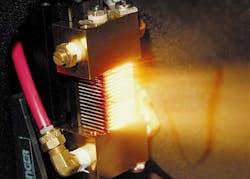Livermore Lab seeks to partner with industry to develop new high-power laser diode arrays
Lawrence Livermore researchers have issued a sources-sought notice (FBO282-14) for the Lawrence Livermore National Laboratory Announces Opportunity For High Power Laser Diode Arrays program, which focuses on bright, high-power arrays for laser pumps and direct-diode applications.
Up to now, Livermore's work in this area has included combining laser diode beams to increase brightness, as well as developing improved thermal management to enable higher-power and higher-temperature operation of laser diode arrays.
White paper: Advancements in high-power diode lasers for defense applications
Today's precision micro-optics and heat-sinking technology, however, may lead to further improvements, and Livermore scientists are looking for a commercial partner to participate in additional research that could lead to advanced prototype diode arrays.
Scientists from Livermore and an industry partner would work together on research focusing on beam combining to enhance brightness and system cooling to enable scaling to higher-power laser diode arrays.
Livermore scientists would like to determine if beam combining of the optical outputs from several semiconductor laser emitters could provide significantly higher beam quality and brighter diode sources, Livermore officials say.
Related: Tactical laser weapons technology demonstrates its readiness for deployment
Historically, the scalability of beam combining has been limited by the quality of the micro-optics that couple light into and out of the emitters. Misalignment of the micro-optics and tight dimensional tolerances have led to alignment losses and limited ability to combine the outputs of many emitters.
Today's micro-optic coupling techniques, however, could change all that by mitigating this issue and scaling beam-combined arrays to a greater number of elements.
A key limitation on cooling diode arrays is the thermal conductivity of the submounts touching semiconductor chips. Recent materials advances can enable much lower bonding stress with high conductivity submounts and improve thermal management.
These laser technology improvements have the potential for applications of nuclear MEGa-ray technology to prevent nuclear terrorism and safeguard nuclear materials, as well as to provide new tools for domestic production of rare earth elements for clean energy technologies.
Companies interested in partnering with Livermore should respond no later than 24 Jan. 2014 -- this Friday -- with descriptions of specific capabilities, attributes, and skills related to high-power laser diode arrays.
Respond by email to Lawrence Livermore's Connie Pitcock at [email protected]. For questions or concerns contact Pitcock on phone at 925-422-1072, or by email at [email protected].
More information is online at https://www.fbo.gov/spg/DOE/LLNL/LL/FBO282-14/listing.html.
